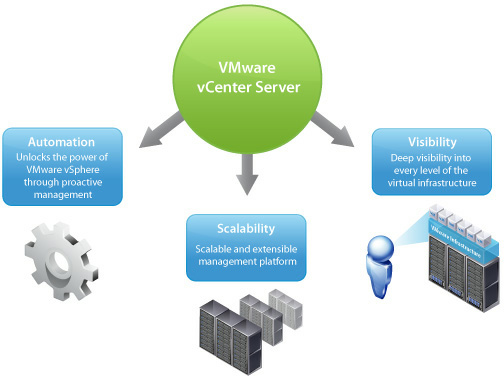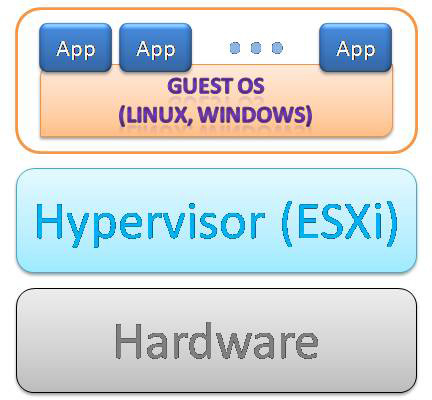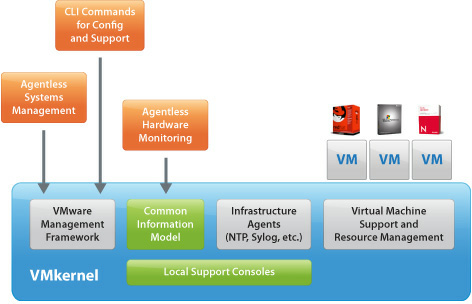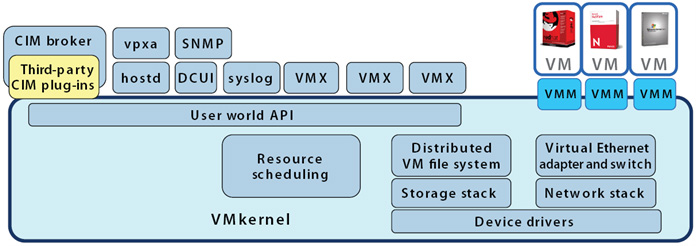|
Like us? Like us! |
| Tweet |
1.5b |
VMware vSphere is a virtualization platform that consists of two primary products: VMware ESXi and VMware vCenter Server. ESXi is the hypervisor and installs on bare-metal hardware without the need for an additional underlying operating system. The hypervisor provides physical hardware resources dynamically to virtual machines as needed to support the operation of the virtual machines.
vCenter Server is a service that acts as a central administrator for ESXi hosts that are connected on a network. vCenter Server allows you to pool and manage the resources of multiple hosts.
vCenter Server comes in two versions: Standard (up to three ESX servers) and Foundation (large-scale vCenter Server deployments).
vCenter Server performs the following three key functions:
Visibility |
vCenter Server allows you to configure ESX servers and VMs, as well as monitor performance throughout the entire infrastructure, using events and alerts | |
|---|---|---|
Scalability |
The visibility found in vCenter Server is scalable across hundreds of ESX servers and thousands of VMs | |
Automation |
vCenter Server alerts can trigger actions and the actions can be automated using the Orchestrator feature |
vCenter Server provides centralized management and allows administrators to configure and monitor ESXi hosts, provision virtual machines, storage, networking, and much more. Depending on the vCenter Server edition, you can use features such as vMotion, Fault Tolerance, DRS, etc. vCenter Server acts as a central control point for your ESXi hosts. You have the ability to connect to each ESXi host individually or manage multiple ESXi hosts and apply advance features via the vCenter Server.

vSphere features such as VMotion, Storage VMotion, Distributed Resource Scheduler, VMware High Availability and Fault Tolerance require vCenter Server.
vCenter Server Components |
Description |
|---|---|
| vCenter Server plug-ins | Applications that provide additional features and functionality to vCenter Server. |
| vCenter Server database | Persistent storage area for maintaining the status of each virtual machine, host, and user. |
| Tomcat Web server | Many vCenter Server functions are implemented as Web services. Requiring Tomcat Web server. |
| vCenter Server agent | On each managed host, the software that collects, communicates, and executes the actions received from vCenter Server. |
| Host agent | On each managed host, the software that collects, communicates, and executes the actions received through the vSphere Client. |
| LDAP | Lightweight Directory Access Protocol (LDAP) synchronizes data such as license and role information across vCenter Server systems joined in Linked Mode. |
| vSphere Client | |
| vSphere Web Client |
The bare-metal architecture gives ESXi complete control over the server resources and provides for improved virtual machine performance and scalability. The hypervisor is installed on the physical hardware and acts as a platform for virtual machines. The hypervisor allows virtual machines to operate with a degree of independence from the underlying physical hardware.

ESXi is the hypervisor or virtualization platform on which you create and run virtual machines in a vSphere environment.
An abbreviated history of ESXi:
- VMware ESXi 3.5 First Public Release (December 31, 2007)
- VMware ESXi 3.5 Update 5
- VMware ESXi 4.0 (May 21, 2009)
- VMware ESXi 4.0 Update 4 (November 17, 2011)
- VMware ESXi 4.1 (July 13, 2010)
- VMware ESXi 4.1 Patch 8 (June 14, 2012)
- VMware ESXi 5.0 (August 24, 2011)
- VMware ESXi 5.0 Update 1 (March 15, 2012)
ESXi is designed for distribution in various formats, including directly embedded in the firmware of a server or as software to be installed on a server’s boot disk.
The size of the ESXi (5.0) image is 144 MB on disk. This size may increase with future updates, fixes, drivers and functionality. The compact architecture is designed for integration directly into virtualization-optimized server hardware, enabling rapid installation, configuration, and deployment.
On ESXi hosts, the management component is based on a limited implementation of the POSIX environment and interface and an integrated set of busybox tools.

The VMware ESXi architecture comprises the underlying operating system, called VMkernel, and processes that run on top of it. VMkernel provides means for running all processes on the system, including management applications and agents as well as virtual machines. It has control of all hardware devices on the server, and manages resources for the applications. The main processes that run on top of VMkernel are:
- Direct Console User Interface (DCUI) — the low-level configuration and management interface, accessible through the console of the server, used primarily for initial basic configuration.
- The virtual machine monitor (VMM), which is the process that provides the execution environment for a virtual machine, as well as a helper process known as VMX. Each running virtual machine has its own VMM and VMX process.
- Various agents used to enable high-level VMware Infrastructure management from remote applications.
- The Common Information Model (CIM) system: CIM is the interface that enables hardware-level management from remote applications via a set of standard APIs.

VMkernel is a POSIX-like operating system developed by VMware and provides certain functionality similar to that found in other operating systems, such as process creation and control, signals, file system, and process threads. It is designed specifically to support running multiple virtual machines and provides such core functionality as:
- Resource scheduling
- I/O stacks
- Device drivers
VMkernel uses a simple in-memory file system to hold the ESXi configuration files, log files, and staged patches.
This file system is independent of the VMware VMFS file system used to store virtual machines.
The in-memory file system does not persist when the power is shut down, as a result log files do not survive a reboot. ESXi has the ability to configure a remote syslog server, enabling you to save all log information on an external system.
The term “user world” refers to a process running in the VMkernel operating system. The environment in which a user world runs is limited compared to what would be found in a general-purpose POSIX-compliant operating system such as Linux.
The DCUI is the local user interface that is displayed only on the console of an ESXi system. It provides a BIOS-like, menu-driven interface for interacting with the system. Its main purpose is initial configuration and troubleshooting tasks. The intention is that the user carries out minimum configuration with the DCUI, then uses a remote management tool to perform all other configuration and ongoing management tasks.
Agents used by VMware (e.g. hostd, vpxa) to implement certain management capabilities are run in “user worlds”.
A number of network ports are open on ESXi, such as: 80, 443 (reverse proxy), 427 (service location protocol), 902, 5989.
References:
- http://www.vcritical.com/2011/05/understanding-vmware-vsphere-esxi-and-release-cycles/
- http://www.virtuallanger.com/2011/09/13/vcp-5-objective-1-5-identify-vsphere-architecture-and-solutions/
- http://blog.mwpreston.net/vcp-5/vcp-objective-1-5-identify-vsphere-architecture-and-solutions/
- http://en.wikipedia.org/wiki/VMware_ESX
- http://www.vmware.com/files/pdf/VMware-ESX-and-VMware-ESXi-DS-EN.pdf
- http://www.vmware.com/products/vsphere/esxi-and-esx/compare.html
- http://www.vmware.com/files/pdf/ESXi_architecture.pdf
- http://www.vcritical.com/2008/10/vmware-esxi-and-hyper-v-installation-comparison/
1.5b |